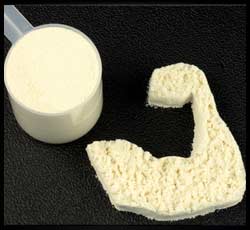 Phase III: Recovery Series
Phase III: Recovery Series
If you remember correctly, the purpose of consuming whey protein post-workout is because whey protein is immediately absorbed into the body as compared to egg proteins and/or caseins with which absorb at a considerably slower rate. For this reason, those proteins are termed "slow release." They do not actually release slowly, but because they all absorb at a slightly different pace, your body is absorbing proteins for a extended period of time, as opposed to if you consume whey protein and get your full shot of protein all at once. The fact that whey protein absorbs immediately is the catcher here. Remember that oh-so-important window of opportunity? Doesn't it make sense that if you have only an hour to get the nutrients your body needs, you would want to consume the fastest absorbing nutrients around? This is also why you should be taking your carbohydrates in liquid form, because they are readily available for use.
To find out exactly how much protein your body needs, simply take your weight in pounds and multiply it with 1 or 1.5, depending on how much protein you are trying to intake.
Example: 1.2 x 198 lbs. = 237.6g = ~240 grams protein per day. Divide this number by 6 meals and you should be consuming ~40 grams of protein per meal.
Some great tasting recipes are as follows: (for women, cut recipe in half)
- 2 scoops ZERO CARB® Chocolate protein powder mixed with 12-16 ounces apple juice.
- 2 scoops ZERO CARB® Graham Cracker protein powder blended with handful of blueberries and ice in 10-12 ounces of water.
- 2 scoops any flavor Syngex mixed with 12-16 ounces water.
- 2 scoops ZERO CARB® Strawberry protein powder mixed with 12-16 ounces of pineapple juice and/or cranberry juice.
Facts about whey protein:
"Little miss muffet sat on her tuffet eating her curds and WHEY." I’m sure most of you have heard this nursery rhyme at one point or another, and, if you were a young child, you were probably thinking "what the heck is curds and whey?!?!" Well, here is your answer. Both whey and casein are milk proteins and become separated during cheese production. A great example is cottage cheese. Cottage cheese has lumps in it called curds. When you make cottage cheese you heat the milk until it curdles (lumps are being formed) and a liquid remains. The curds contain a protein called caseins, while the thin liquid left over is whey protein. It is actually only less than 1% protein, therefore; it is concentrated and dried to produce whey protein powder. Whey protein is a great way to get your dose of Branch-Chain Amino Acids (BCAAs). The primary function of BCAAs is nitrogen retention and protein synthesis, both of which are essential for muscle growth.
Whey protein is considered to be "rapidly absorbed" because of the amount of time it takes to be fully metabolized by the body. Fully metabolizing a protein means that it will be digested, absorbed into the blood, taken up by bodily tissue, and then completes a metabolic function. Whey protein will likely either used in the formation of new protein or oxidation into urea. 20 minutes is all your body needs to get the whey protein flowing through your veins, and in only somewhere between 20-40 minutes, the level of amino acids in your blood has skyrocketed. Within an hour, either protein synthesis or oxidation has occurred. So in just 40 minutes, blood levels of amino acids and protein synthesis has reached its peak. This is crazy fast as compared to any other form of protein, hence why whey protein is the right choice for your post-workout meal.
E. Satterwhite Should I Take Casein Or Whey Protein? Bodybuilding.com 02/05/2007






